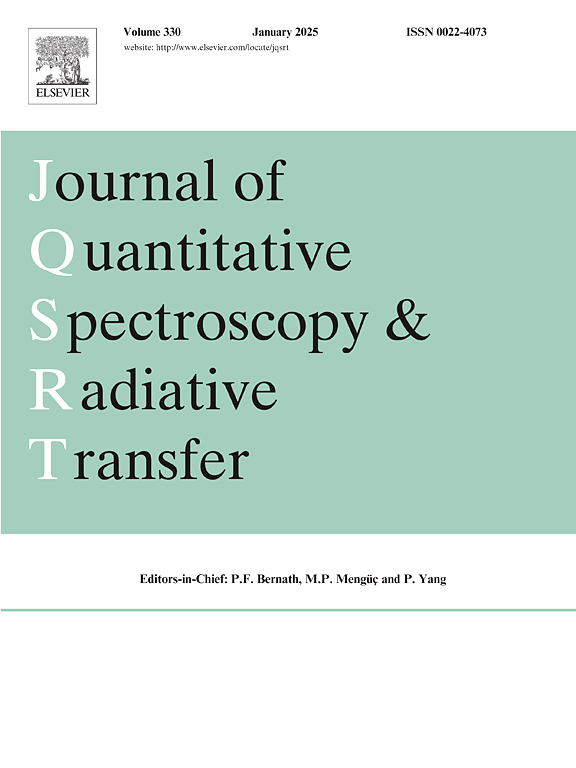Line-shape parameters and their temperature dependence for self-broadened CO2 lines in the 296 K- 1250 K range by requantized classical molecular dynamics simulations
IF 2.3
3区 物理与天体物理
Q2 OPTICS
Journal of Quantitative Spectroscopy & Radiative Transfer
Pub Date : 2024-11-08
DOI:10.1016/j.jqsrt.2024.109264
引用次数: 0
Abstract
Line-shape parameters for self-broadened CO2 transitions are predicted for temperatures ranging from 296 K to 1250 K, using requantized molecular dynamics simulations (rCMDS). The line broadening coefficient, the speed dependence component and the first-order line-mixing coefficient for lines with rotational quantum number from 2 to 100, have been determined from fits of the rCMDS spectra with the Voigt and speed dependent Voigt profiles. These parameters and their temperature dependence were compared with recent high-quality measurements at both room and high temperatures, showing good agreements for all considered parameters. In particular, this study highlights that the temperature dependence of the speed dependent Voigt line broadening coefficient in the HITRAN database needs to be corrected. Additionally, we demonstrate that the temperature dependence for the speed-dependence of the line broadening differs from that of the line broadening, contrary to the assumption widely used in the literature. These findings confirm the quality of theoretical predictions using rCMDS. The data provided can be used to complete and improve spectroscopic databases for various applications.
通过重量化经典分子动力学模拟研究 296 K-1250 K 范围内自展宽二氧化碳线的线形参数及其温度依赖性
利用再量化分子动力学模拟(rCMDS)预测了 296 K 至 1250 K 温度范围内二氧化碳自展宽跃迁的线形参数。通过对 rCMDS 光谱与 Voigt 和速度相关 Voigt 曲线的拟合,确定了旋转量子数为 2 到 100 的线的线展宽系数、速度相关分量和一阶线混合系数。将这些参数及其与温度的关系与最近在室温和高温下进行的高质量测量结果进行了比较,结果表明所有考虑的参数都具有良好的一致性。这项研究特别指出,HITRAN 数据库中与速度相关的 Voigt 线展宽系数与温度的关系需要修正。此外,我们还证明了线展宽与速度相关的温度依赖性与线展宽的温度依赖性不同,这与文献中广泛使用的假设相反。这些发现证实了使用 rCMDS 进行理论预测的质量。所提供的数据可用于完善和改进各种应用的光谱数据库。
本文章由计算机程序翻译,如有差异,请以英文原文为准。
求助全文
约1分钟内获得全文
求助全文
来源期刊
CiteScore
5.30
自引率
21.70%
发文量
273
审稿时长
58 days
期刊介绍:
Papers with the following subject areas are suitable for publication in the Journal of Quantitative Spectroscopy and Radiative Transfer:
- Theoretical and experimental aspects of the spectra of atoms, molecules, ions, and plasmas.
- Spectral lineshape studies including models and computational algorithms.
- Atmospheric spectroscopy.
- Theoretical and experimental aspects of light scattering.
- Application of light scattering in particle characterization and remote sensing.
- Application of light scattering in biological sciences and medicine.
- Radiative transfer in absorbing, emitting, and scattering media.
- Radiative transfer in stochastic media.

 求助内容:
求助内容: 应助结果提醒方式:
应助结果提醒方式:


